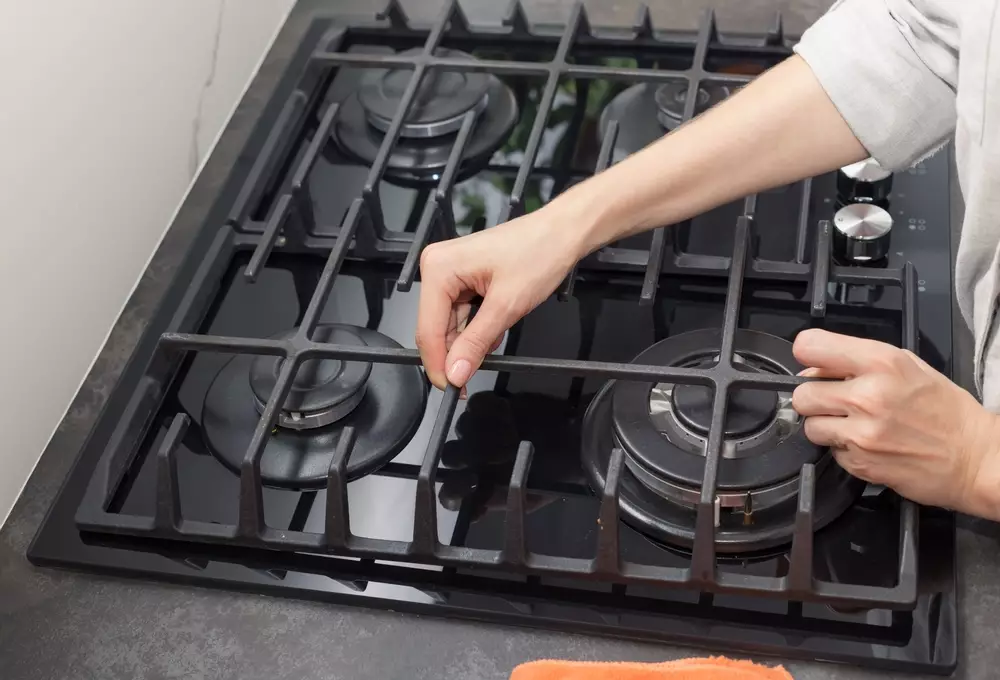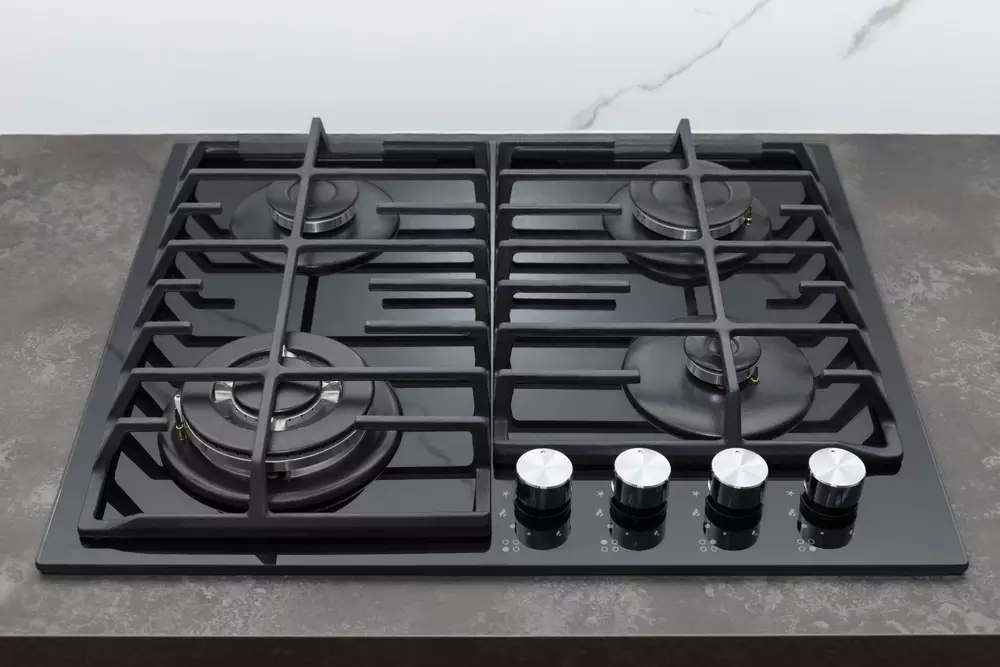Cleaning gas stove top grates is an essential task to maintain a sparkling and hygienic kitchen. Over time, these grates can accumulate grease, food residue, and stubborn stains, making them appear unsightly and affecting their performance. How to clean gas stove top grates? Fortunately, with a few simple steps, you can restore the gleam and functionality of your gas stove top grates.
By employing effective cleaning techniques and utilizing common household items, you’ll be able to tackle the challenge with ease, ensuring a spotless cooking surface for your culinary endeavors.
Importance of Regular Cleaning for Gas Stove Efficiency
A clean gas stove not only enhances the overall appearance of your kitchen but also plays a significant role in ensuring its efficiency. Regular cleaning of your gas stove helps to maintain optimal performance and functionality.
Over time, food particles, grease, and debris can accumulate on the burners, grates, and other components, causing blockages and hindering the flow of gas. This build-up can lead to uneven heating, reduced flame intensity, and inefficient fuel consumption.
By prioritizing regular cleaning, you can remove these obstructions, promote proper airflow, and ensure that your gas stove operates at its best, providing you with faster and more precise cooking results while also extending its lifespan.

Step-by-Step Guide to Cleaning Gas Stove Top Burners
Cleaning a gas stove burner is a straightforward process that can greatly improve the performance and appearance of your stove. Follow these step-by-step instructions to effectively clean your gas stove burners:
- Safety First: Before starting the cleaning process, ensure that the gas supply to the stove is turned off and the burners are completely cool.
- Remove the Burners: Carefully lift and remove the burner grates from the stove. Depending on your stove model, you may need to unscrew or detach the burners from the gas supply.
- Soak in Soapy Water: Fill a sink or basin with warm water and add a few drops of mild dish soap. Submerge the burners in the soapy water and let them soak for about 15 to 20 minutes. This will help loosen grease and debris.
- Scrubbing: After soaking, use a soft brush or sponge to gently scrub the burners. Pay close attention to the burner ports or holes, as they tend to accumulate stubborn residue. For tough stains or caked-on grime, you can use a toothbrush or a small brush with bristles to scrub more effectively.
- Rinse and Dry: Once the burners are thoroughly scrubbed, rinse them under warm running water to remove any remaining soap residue. Ensure that all the soap is washed off. Shake off any excess water and pat dry with a clean towel or let them air dry completely.
- Clean the Burner Grates: While the burners are drying, take the opportunity to clean the burner grates. Use a brush or sponge to remove any loose debris, and then wipe them down with a damp cloth or sponge.
- Reassemble and Test: Once the burners and grates are dry, reassemble them back onto the stove. Make sure they fit securely and are aligned correctly. Turn on the gas supply and test the burners to ensure they are functioning properly.
Removing Stubborn Stains from Gas Stove Grates
Removing stubborn stains from gas stove grates can be a challenging task, but with the right approach, you can restore them to their original cleanliness. Follow these steps to effectively remove stubborn stains from your gas stove grates:
- Safety Precautions: Before you begin, ensure that the gas supply to the stove is turned off and the grates have cooled down completely to avoid any accidents.
- Preparing the Cleaning Solution: Create a paste by mixing equal parts baking soda and water in a bowl. Baking soda is a natural abrasive that can help lift and loosen stubborn stains.
- Applying the Paste: Take a sponge or a soft brush and apply the baking soda paste generously onto the stained areas of the gas stove grates. Ensure that the paste covers the stains completely.
- Soaking Time: Allow the baking soda paste to sit on the stains for at least 15 to 20 minutes. This will give the paste enough time to penetrate the stains and work on breaking them down.
- Scrubbing: After the soaking time, use a scrub brush or a non-abrasive sponge to scrub the stained areas vigorously. Focus on the stubborn stains and use circular motions to loosen the grime.
- Rinse and Inspect: Once you have thoroughly scrubbed the stains, rinse the gas stove grates under warm running water. Ensure that all the baking soda residue is washed away. Inspect the grates to see if any stains remain.
- Repeat if Necessary: For particularly stubborn stains that have not been fully removed, repeat the process of applying the baking soda paste and scrubbing. Sometimes, multiple rounds of cleaning may be required for deeply embedded stains.
- Final Rinse and Dry: After all the stains have been successfully removed, give the gas stove grates a final rinse under warm water to remove any remaining residue. Shake off any excess water and pat dry with a clean towel or let them air dry completely before reattaching them to the stove.
Common Mistakes to Avoid When Cleaning Gas Stove Grates
When it comes to cleaning gas stove grates, it’s important to be aware of common mistakes that can hinder the cleaning process or potentially damage the grates. Avoiding these mistakes will help you achieve better results and prolong the lifespan of your gas stove grates.
- Using Abrasive Cleaners: Avoid using harsh or abrasive cleaners, such as steel wool or abrasive powders, as they can scratch the surface of the grates. Opt for gentler cleaning methods to prevent damage.
- Neglecting Regular Cleaning: Waiting too long between cleanings can make the task more challenging. Regularly clean your gas stove grates to prevent the buildup of stubborn stains and grease, which can become harder to remove over time.
- Cleaning Hot Grates: Cleaning grates while they are still hot is a common mistake that can lead to burns. Always allow the grates to cool down completely before attempting to clean them.
- Soaking Grates in Water for Extended Periods: While soaking grates can help loosen stains, avoid leaving them submerged in water for an extended period. Prolonged exposure to water can cause corrosion or damage to certain types of grates. Follow recommended soaking times and promptly rinse and dry the grates afterward.
- Skipping the Rinse Step: After scrubbing the grates, it’s important to thoroughly rinse off any cleaning agents or residue. Skipping this step can leave behind unwanted residue that may affect the taste or safety of your food.
- Not Drying the Grates Properly: After cleaning, ensure that the grates are completely dry before reattaching them to the stove. Moisture left on the grates can lead to rust or corrosion.
The Benefits of a Clean Gas Stove: Improved Cooking Experience
Keeping your gas stove clean offers numerous benefits that directly contribute to an improved cooking experience. Here are the key advantages of maintaining a clean gas stove:
- Enhanced Efficiency: A clean gas stove functions at its optimal efficiency. When burners and grates are free from grease, food residue, and debris, they can provide consistent heat distribution and a more precise flame. This allows for better control over cooking temperatures, resulting in improved cooking outcomes.
- Reduced Cooking Time: A clean gas stove heats up faster and more evenly. Without obstructions on the burners, heat can be transferred efficiently to your cookware, reducing cooking time. This means you can prepare meals more quickly, saving valuable time in the kitchen.
- Elimination of Odors: Lingering food odors can impact the flavor of your dishes. A clean gas stove minimizes the buildup of cooking odors, preventing them from permeating your kitchen. This ensures that the natural aromas and flavors of your food shine through.
- Prevention of Flavor Transfer: Residue and grease buildup on gas stove grates can transfer flavors from previous meals to subsequent dishes. By regularly cleaning your stove, you can prevent cross-contamination of flavors and ensure the purest taste for each recipe.
- Improved Kitchen Safety: Grease and food residue on a gas stove can pose a fire hazard. A clean stove reduces the risk of accidental fires and enhances kitchen safety for you and your family.
- Extended Lifespan of the Stove: Regular cleaning and maintenance help prolong the lifespan of your gas stove. Removing grease, stains, and debris prevents corrosion and damage to critical components, ensuring your stove remains in good working condition for years to come.
- Health and Hygiene: Cleaning your gas stove eliminates potentially harmful bacteria and germs that can accumulate on surfaces. This promotes a healthier cooking environment and reduces the risk of foodborne illnesses.
Conclusion
Maintaining a clean gas stove is crucial for an improved cooking experience. By regularly cleaning your gas stove, you can enhance its efficiency, reduce cooking time, eliminate odors, prevent flavor transfer, promote kitchen safety, create an aesthetically pleasing environment, extend the lifespan of your stove, and ensure a healthier cooking space.
Investing time and effort in cleaning your gas stove will not only yield better cooking results, but also contribute to a more enjoyable and hygienic culinary journey. So, make it a habit to keep your gas stove clean and reap the benefits of a well-maintained cooking appliance.
